Does mezcal go bad? Or more specifically, does mezcal in an opened bottle eventually go bad? We’ve seen several threads on Facebook, Reddit, and elsewhere over the years that have asked this question. Some have posited that oxygen or oxidization would have a negative impact on the spirits over time. Others have referred to results of scotch or whiskeys changing drastically if not consumed within a reasonable amount of time after opening. Opinions on the subject tend to vary greatly, but there seem to be three main positions that people take:
- Mezcal left in a bottle that has been opened will stay the same or actually improve
- Mezcal left in a bottle that has been opened will improve to a certain point, but then go bad if there is too little mezcal left in the bottle
- Mezcal left in a bottle that has been opened will eventually go bad
Our friend Mezcal PhD tells us that mezcal will likely improve over time. He says;
“If you open your bottles once a year or so and let new air in (assuming you did not drink it all), the mezcal will improve over time. Acetaldehyde is present in a distilled mezcal. When exposed to air, this oxidizes to acetic acid, which is ester. We love esters in spirits because they are associated with positive smells and flavors like banana, pineapple, and sugar. By letting fresh air in every year or so, you are re-energizing the process.”
According to him, there’s some sound science to the fact that mezcal would change over time, but we wanted some experiential evidence that it would indeed change for the better.
We also asked co-founder of Mezcal Vago, Judah Kuper, the same question last year. His answer was similar to Mezcal PhD in that he believed that mezcal improved after the bottle was opened. His theory was that mezcal would continue to improve until the bottle would get down to about 25% full, at which time he suggested that you should just drink the remaining mezcal because it would start to drastically change (presumably for the worse). This belief seems to be held by many in the industry, and we’ve spoken to several users of this website who prefer to re-bottle their mezcal to a smaller glass bottle (like a dram or something similar) once the original bottle gets below that 25% threshold. This seems to vary pretty widely, but many have a tradition or practice for dealing with low bottles.
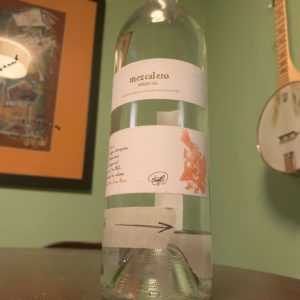
Mezcalero No. 14 intentionally left for seven months with very little remaining in the bottle.
Still other members of this website have written to us about noticing significant differences in older opened bottles, which they’ve posited was due to oxidation and/or evaporation. Does oxidation or evaporation make them worse or just different? Generally, we’ve found that older bottles tend to mellow and get better over time. But is this true for bottles that are less than 25% full? We pulled a few lower ABV mezcals off the shelf earlier this year. They’d each been open for over a year with about 25% of the bottle left. Unfortunately, they didn’t taste very good, but maybe they weren’t really all that enjoyable to begin with?
Aged-in-Glass
While questions about the aging of mezcal in opened bottles is an active debate, the community seems decided on the aging of mezcal in closed (never-opened) bottles and/or in larger glass demijans. For those unfamiliar with the Aged-in-Glass or Madurado style, this refers to the aging of mezcal in glass after it is distilled. Some releases will be aged in glass for upwards of two or three years before being bottled for sales and general consumption. You’ll often see special prized batches of mezcal aging in glass at palenques around Oaxaca.
Aging in wooden barrels, which is done widely for whiskey and tequila, is less common in Mezcal. Barrel aging typically removes the more vegetal notes of the agave and replaces them with notes of the wood, like caramel, brown sugar, or vanilla. Aging in glass, however, imparts no new flavors. While the flavor of the mezcal does indeed change as it ages, the aging in glass tends to enhance what is already present, making the mezcal more balanced, integrated, and settled. The growing popularity of mezcal that is aged-in-glass clearly emphasizes the importance of time on how distilled agave can settle and build structure long after it has left the still. So we know that time can play an integral role in improving mezcal, but what about other elements, like the amount of air in the bottle and the oxygenation and/or evaporation process that occurs when there’s very little mezcal left in the bottle?
The Mezcal Aging Experiment
Rather than pontificate, we decided to do some hard core research. On March 19, 2019 we selected four of our favorite bottles. They had all been open for a little over a year and all the bottles had just over 25% left. We poured the four bottles of mezcal into smaller air tight 250ml glass containers. In the original bottles, we left about 2-3oz of mezcal to interact with the air left in the bottle. Our theory was that the air in the original bottle would have some impact on the aromas, flavor, and complexity of the mezcal over time. Would this impact be good or bad? We weren’t sure.
So on October 18, 2019 (seven months later), we performed a blind tasting, where we compared the original bottle with excess-air with the no-air re-bottled mezcal.
The Tasting Line Up
| Mezcal | Mezcalero | Town | ABV% | Production Date |
| Mezcalero No. 14 | Don Jesus Rios | Sola de Vega, Oax | 47.7% | October 2014 |
| Vago Elote | Aquilino Garcia | Candelaria Yegole, Oax | 50.7% | May 2017 |
| Rey Campero Tepextate | Romulo Sanchez Parada | Candelaria Yegole, Oax | 49% | December 2015 |
| El Jolgorio Barril | Ignacio Parada | Santa Maria Zoquitlan, Oax | 48.2% | 2014 |
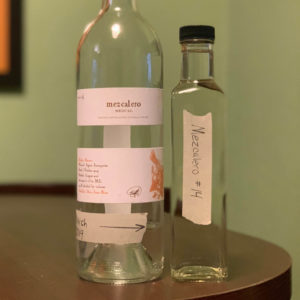
Mezcalero No. 14 (notice levels in each bottle)
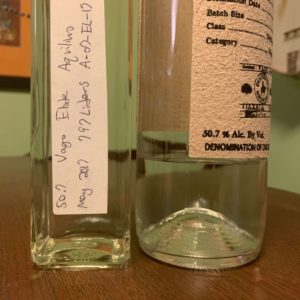
Mezcal Vago Elote
Mezcalero No. 14
> No-air (preferred)
“Soft sweet clay. Sour on the back end. Hints of white grape juice.” — Tyler
“Aromas of peanut butter cups, woody, leather.” — Chris
“Aromas of cinnamon, all spice, sandalwood, and vanilla. Flavors of cinnamon, sand, and slate.” — Jonny
> Excess-air
“Notes of clay. Robust. No sour finish. More notes of dates and hickory.” — Tyler
“Less pungent on the nose. Slightly muted flavor notes but mostly the same.” — Chris
“Muted aromas. Much softer and bit lighter on the palate. Similar tasting notes but less pronounced. More mellow but less exciting.” — Jonny
Overall, the Mezcalero No. 14 had slight differences from the different aging. We noticed this more on the nose than on the palate, with more of the aromas in the No-air mezcal being more pronounced and bold. We all preferred the No-air mezcal as it was a bit bolder and held a strong punch with it’s various notes and characteristics.
Vago Elote
> No-air
“Notes of white pepper, salt, corn nuts. Strong finish.” — Tyler
“Nose has notes of maple syrup and pancakes. Strong tastes of alcohol.” — Chris
“Strong aromas of corn, a bit of nail polish, coffee, and maple pecan. Tastes of grilled elote. Very sweet. A bit of nail polish on the palate as well.” — Jonny
> Excess-air (preferred)
“Strong notes and aromas. Very little difference between the two.” — Tyler
“Similar notes on the nose but more like cornmeal than pancakes. More mellow.” — Chris
“Still strong aromas. Very similar, but more mellow and balanced.” — Jonny
Overall, the Vago Elote showed slight differences between the two aged mezcals, but we all agreed that we preferred the Excess-air mezcal. It was much more mellow and all of the nail polish/alcohol notes had vanished over time, making this an incredibly rounded and balanced Elote.
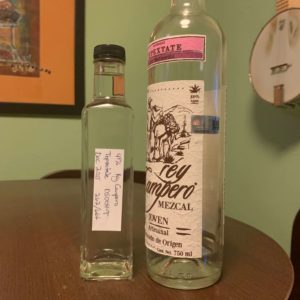
Rey Campero Tepextate (notice levels in each bottle)
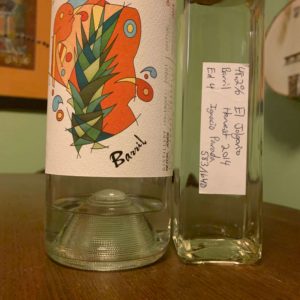
El Jolgoio Barril
Rey Campero Tepextate
> No-air
“Candied peppers, Dr. Pepper, and Jelly Beans. Short finish.” — Tyler
“Lavender flavors, a bit of alcohol present. Short finish. ” — Chris
“Strong notes of green pepper, coffee, jalapeno, lavender, and mint. The palate is like a basket full of fresh peppers. Stronger aromas on this one, but very short finish.” — Jonny
> Excess-air (preferred)
“Cinnamon, cotton candy, lingering pepper jerky finish.” — Tyler
“More mellow nose and aromas. Notes of chocolate, rose pedals. Long finish.” — Chris
“Lighter nose and more creamy notes and vanilla on the palate. Much softer and more delicate than the first.” — Jonny
Overall, the Rey Campero Tepextate was our favorite from the evening. While that has nothing to do with aging, it’s worth noting that this stuff remained stellar. We all agreed that the finish on the Excess-air mezcal was much longer and more pronounced. The finish on this actually extended and was enhanced by the presence of the air in the bottle. Like the Elote, the Excess-air mezcal was our favorite for the Rey Campero Tepextate.
El Jolgorio Barril
> No-air
“A bit funky with some burnt notes on the back of the palate.” — Tyler
“Notes of ash and firewood on the nose and palate.” — Chris
“Alcohol on the nose. Palate has beets and root vegetables with a bit of cigarette ash.” — Jonny
> Excess-air (preferred)
“Very similar but more mellow with fewer of the burnt notes present.” — Tyler
“Almost identical nose and palate but a bit more blended in flavor.” — Chris
“Softer nose. Softer palate. More balanced and mellow.” — Jonny
Overall, the El Jolgorio Barril showed slight differences between the two different aged mezcals. Like the Vago Elote and the Rey Campero Tepextate, we all found that the Excess-air was our preferred option among the two.
Conclusion
We weren’t sure what to expect from this tasting, but we’d hypothesized that the air in the bottle would indeed have some impact on the mezcal after seven months. In the end, we found that our hypothesis was correct. Generally speaking, the Excess-air mezcals were all much more mellow and balanced than those that had been resting in a bottle with little/no air. Of the four mezcals included in this tasting, we preferred the Excess-air mezcal for three of them.
While this is encouraging news for people (like us) who have dozens of bottles open at any given time, it’s intriguing that the Mezcalero No. 14, which is an incredible mezcal, was the only bottle that we preferred with little/no air. It was the only mezcal in the group that was distilled in clay. It also had marginally lower ABV than the others. Could one of these factors have made the difference? That’s a question for a future tasting.
For now, it seems safe to say that your mezcal will not go bad from having too much air in the bottle. In fact, as Mezcal PhD had posted, the air appears to help your mezcal become subjectively more enjoyable over time. What’s your ritual for keeping mezcal after the bottle is opened (assuming you don’t just drink it)? Have you noticed differences in bottles that have been open for extended periods of time? Are your mezcals getting better as they age?


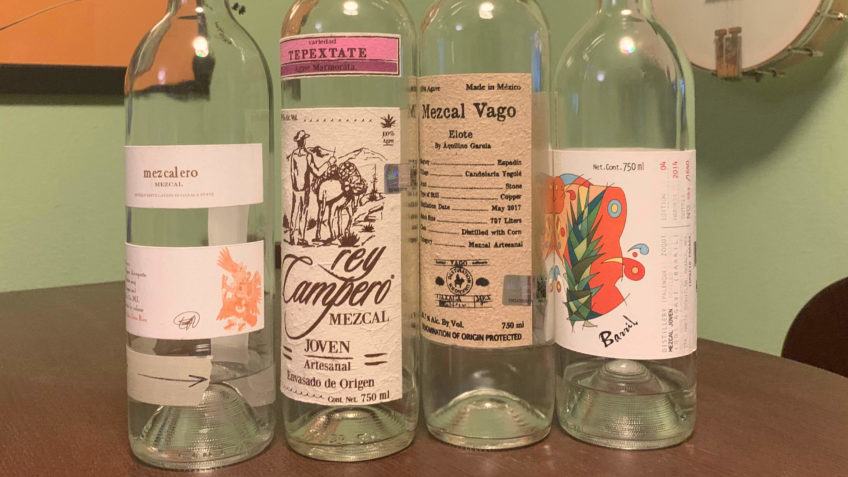
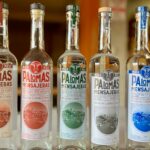
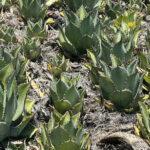
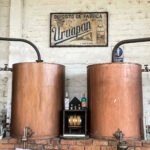
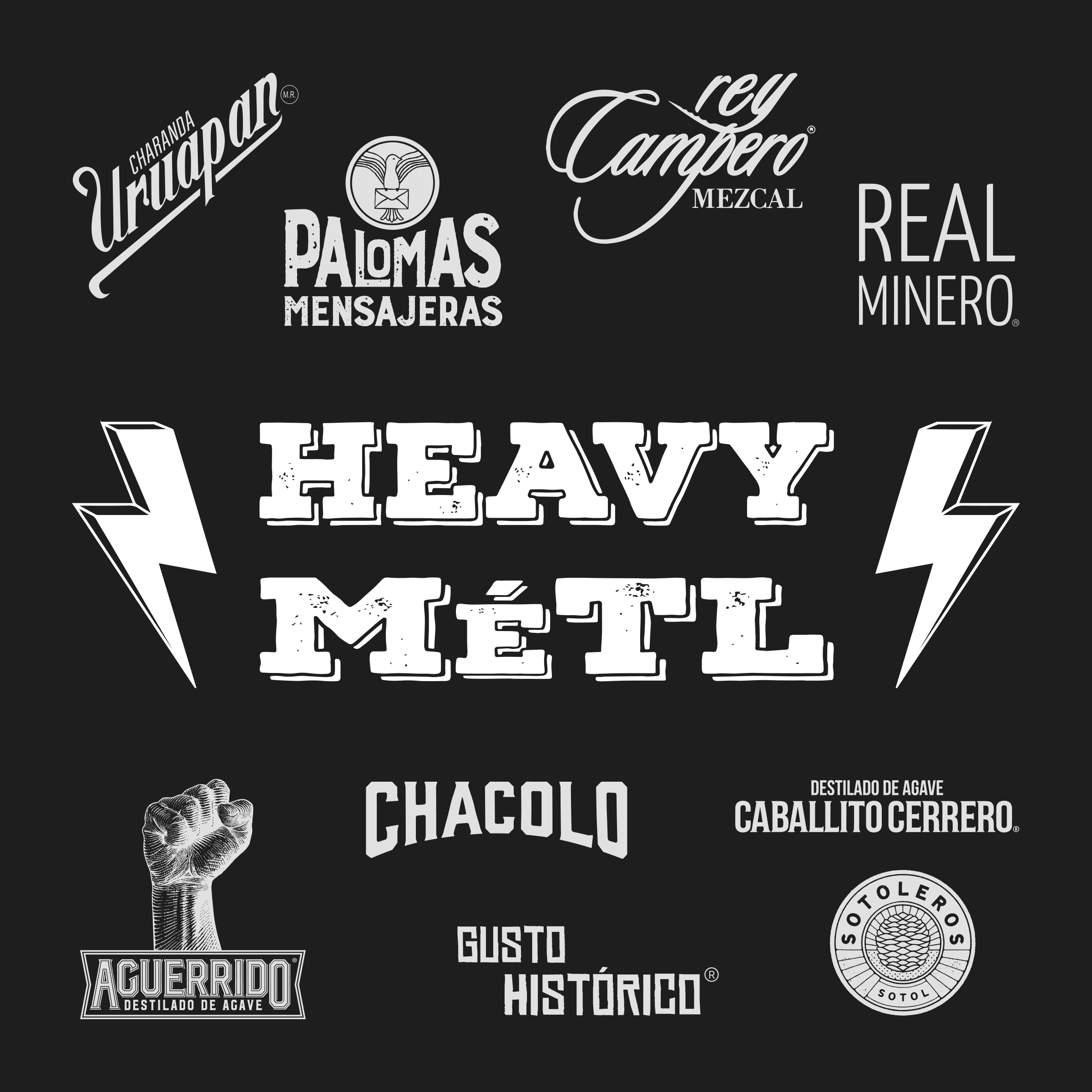
Jesse Murphy
3 years agoThis experiment was fun to read and be a part of; I greatly enjoyed it! I do similar things with my Mezcals; however, I divide my Mezcal into a 350 ml bottle (with synthetic cork and fully loaded, with a small air pocket), and keep the rest in it’s original bottle. I do notice subtle differences; however, I’m at the point where I never want to waste my money on any expression that has an acetone, overly alcohol, or leathery smell, from the get go. Mezcaleroes are loosing me as a customer… I’m headed back over to the sweet cooked agave (additive free) Tequila camp. Yet, I believe I’ll always be a LaLocura fanboy; closely followed by Real Minero and some Rey Compero’s when I seek a more copper pot flavored/made Mezcal; something a drop more hot or edgy.
Tom
3 years agoI have a sealed bottle of Mezcal I gave to my dad 30 years ago. It’s not in a glass bottle, it’s in a black small round ceramic bottle with a worm on it. It has a little bag of salt sealed with it on the top. He had it on his bar forever. It’s never been opened. Is it safe to drink?
JonnyAuthor
3 years agoImpossible to tell without actually having it in front of me, but generally, it should be ok as long as nothing entered the bottle. Your “shot” amigo.
John McEvoy
3 years agoHey guys, I just read this – not sure if I saw it the first time! But I love the experiment, and I am not surprised by the result. As you stated from my book, I do believe the taste will generally improve over time, but I agree with Judah that this has its limits. I did not realize this when I revised my book in 2018, but now I think that if there is just a little bit left in the bottle (less than 25% is a decent marker but it may need to be even lower), it will worsen over time. As I drink down more of my open bottles, I am discovering this. I believe you would have found this if you had let your experiment run for 2 yrs or so, maybe less, but 7 months seems too short. At any rate, love your passion and commitment!!
JonnyAuthor
3 years agoAppreciate the update PhD! I’d agreed that a 2yr experiment like this would probably provide more noticeable differences. As I’m sure you can imagine, the toughest part of this experiment was intentionally leaving these delicious bottles on the shelf (even when they’re hidden in the back of the closet). So 7 months was as long as we could resist temptation.
Frances
3 years agoMexcal Union El Viejo – Didn’t know exactly what it was and was put in my wine fridge after a big party last summer, just reorganizing my fridge and saw it in there amongst the white. can I leave it out now and drink as it was supposed to be – room temp?
JonnyAuthor
3 years agoAs long as nothing was able to enter the bottle, it should be ok.
Chris
4 years agoMongo only pawn in game of life, but this is a great topic. There are many more 250ml bottles in Oaxaca these days. Zapotec economics are like Pemex; a 250ml bottle costs 400 pesos and a 750 is 1,200. The price sheets at Real Minero and other palenques are much the same and there is rarely much of a volume discount at the mercado. I have 250s, 750s and 1L bottles. Overall, my sense is that the open bottles are a bit less astringent and rounder on the palette. Is that necessarily better or simply a choice at the moment between the blue groomer, the black diamond moguls or hiking to the back bowls for the puntas? I’m not rushing to open my stash of unobtaniums with silicone stoppers, but given what’s happened to some of my Bordeaux with dried out corks, it’s time to open the Marca Negra Dobadan and possibly the older Del Maguey although they have the wax seals. Thanks for the insight. I’m looking forward to being in OAX again next month.
JonnyAuthor
4 years agoDefinitely agree about them being less astringent and rounder on the palate. Your note about dried corks is an interesting one to consider. I’ve heard that the alcohol vapors in liquor prevent the cork from drying more than wine corks, but I’m not sure if this is confirmed. Regardless of the vapors, I’d think that tipping the bottles on their side once or twice a year should be enough to keep the cork moist enough to keep a good seal.
Rorschach
4 years agoInteresting and funny that I did kinda the same thing with 4 Rey Campero Espadin bottles of different lots. As all 4 went down in volume over several months the pecking order changed, so the favorite from the beginning fell away to the lesser favorite coming out over time.
Jesse Murphy
3 years agoYes!!!! Bingo!!! I mean, the proof is in the pudding/nosing… and then tasting… ?
Too much acetone/nail polish means too much of the head, and too much astringency (burn) means too much tail… Which, by default seems to also suggest that the distillation was very hot.
Moreover, Fermentation with fibers and then over heating (or heating too long) seem to really stack up the (almost extremely unhealthy for us humans) conengers. The precious agave juice is too precious to throw away… As we know, the heads and tails get mixed back into the 2nd distillations. But, I’m convinced the more expensive bottles (like $150 and up) house mostly only the hearts (the less conengers laden part) for both distillations. I just hope we don’t come to learn one day that most of our beloved Mezcals had some slight additives injected to help make them: dare I say, “smoother”?
Rorschach
4 years agoWhat I am learning is that it has a lot to do with heads-hearts-tails. What I seek is the heart of the distillation, and less blended heads and tails to achieve the same alcohol content, given no dilution. I don’t know if this has any correlation to the aging part, but something I am keeping in mind. It surely has something to do with the $$$ part!
Rorschach
4 years agoThat espadin is 48-49% and the best to me was having a good mouthfeel with the agave flavor. The best one seemed to turn hot/alcoholic and the worst that started out this way seemed to open up more. I really appreciate how a good bottle will hide the high alcohol content. I don’t understand how it locks it up that way, but when it does it seems to give it a really good structure. It’s a good selling point that it doesn’t turn bad like wine.
JonnyAuthor
4 years agoThat sounds like an awesome experiment, very similar to ours. I’m curious if you recall specific characteristics about your least favorite that changed/improved over time. Was it too hot initially, and mellowed over time? Did the flavor change for the better?
nick82
4 years agoWhat perfect timing for this blog. I was just asking somebody about this two days ago. Great little experiment that you guys did,, and the results are very encouraging to those like myself – who have amassed a nice little collection of bottles, but just dabble in them over the course of time. I like making a rotation with what i’m drinking (and small amounts at a time) … so i’ll have several bottles over the next several years that fall will into the category of your experiment.
My question goes back to the “aged in glass” topic … What if we have bottles that haven’t ever been opened, still sealed? … your aged in glass section above says this is a good thing – but what about *hypothetically* many many years without opening a bottle? Have you ever thought about keeping a bottle sealed/unopened until some special day way in the future?
I recently picked up a Real Minero Espadin (batch #L-00401) with a “harvest date” of 2008. You guys write about this in your review for the bottle. Aside from the bottling process, i would suppose this 750ml of mezcal hasn’t been exposed to air in ~11 years.
JonnyAuthor
4 years agoHey Nick. As far as the aged-in-glass goes, we find that the longer the mezcal sits (unopened), the more balanced and integrated it becomes. Tyler and I both have dozens of unopened bottles in “deep storage” in the back of our closets, saving these special bottles for some unknown future event, probably several years from now. If they’re sealed, they should be fine, and they’ll likely get better as they age.